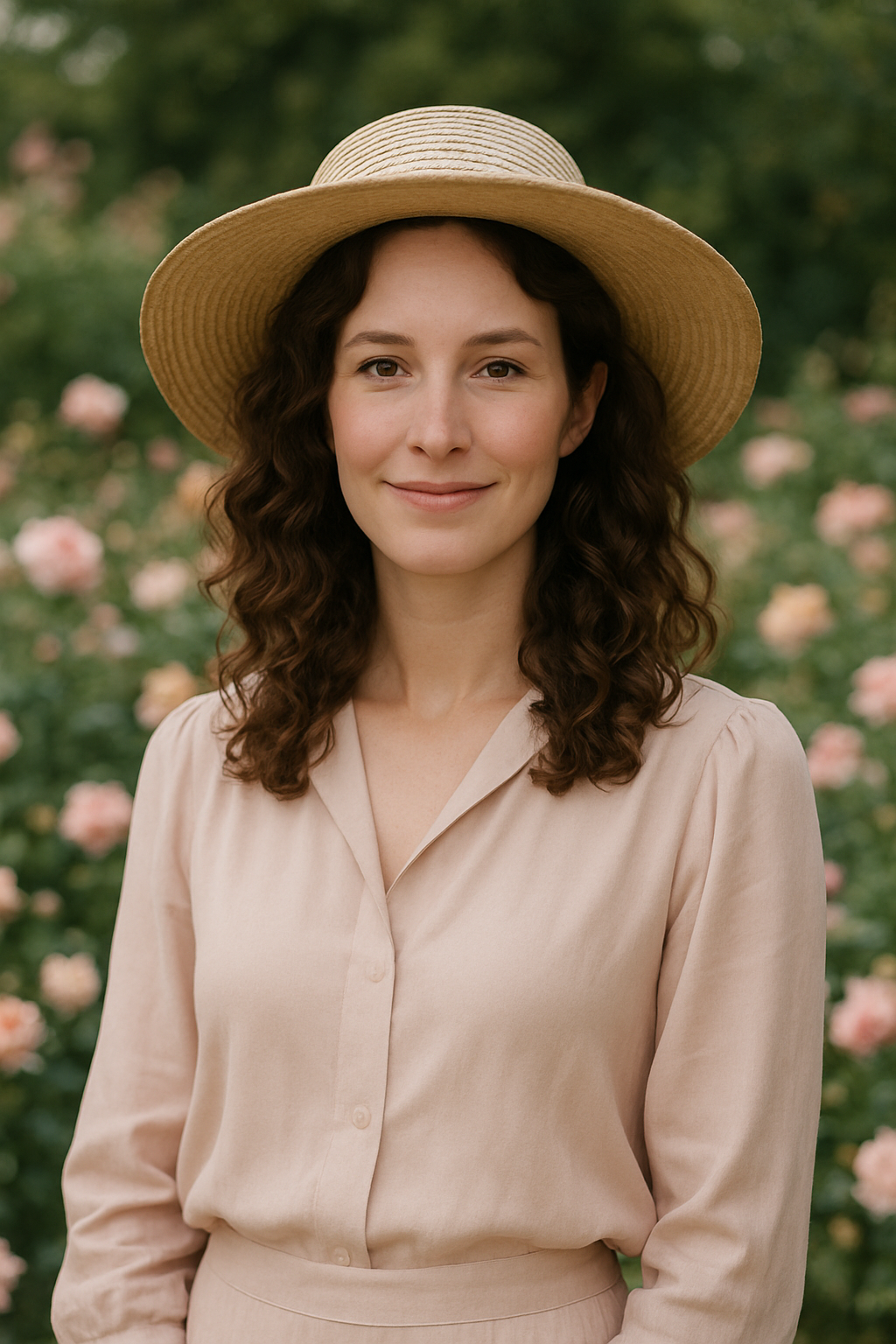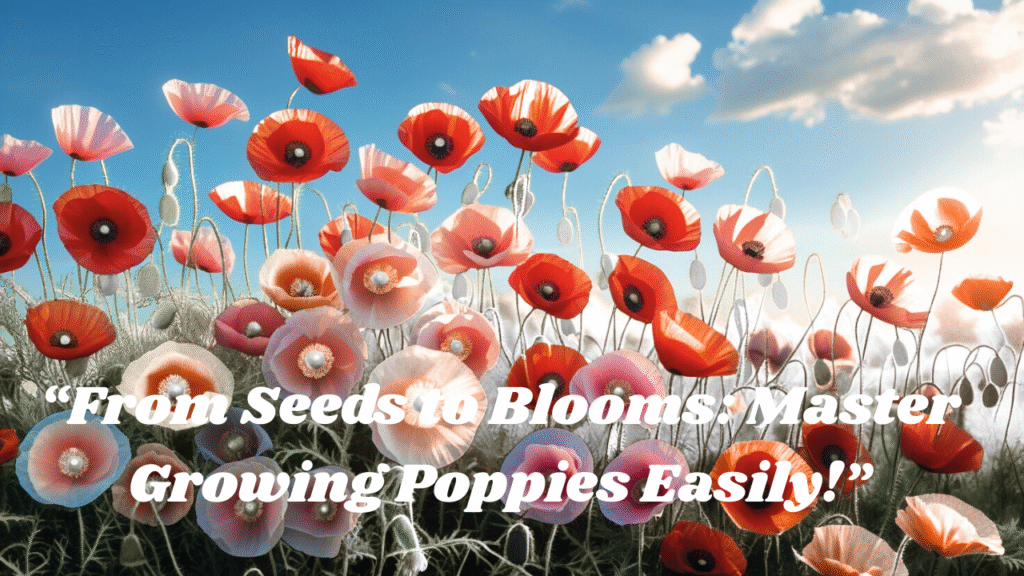
There’s something magical about poppies—the way their delicate petals catch the morning sunlight, the soft rustle in the breeze, and the simple elegance they bring to any garden.
When I first planted poppies in my small backyard patch, I didn’t realize how much joy these flowers could bring. Watching them bloom week after week gave me a sense of calm and satisfaction that no store-bought bouquet could ever replicate. Whether you’re a beginner gardener or an experienced flower enthusiast, learning how to grow poppies can be both rewarding and surprisingly easy with the right guidance. In this guide, I’ll share my personal tips, practical advice, and little tricks I’ve learned over the years to help your poppies thrive—from choosing the right variety to solving common gardening challenges.
Introduction to Poppies
Poppies are not just beautiful—they are symbols of remembrance, resilience, and delicate charm. These vibrant flowers are loved worldwide for their range of colors and their ability to flourish in a variety of climates.
If you’re starting a flower garden or looking to add a splash of color, poppies are a must-have. But beyond their visual appeal, they are low-maintenance, making them perfect for U.S. gardeners seeking beauty without constant fuss. Understanding the unique qualities of poppies helps you choose the right types for your garden, ensuring long-lasting blooms and a healthy, thriving patch.
Why Poppies Are a Must-Have in Your Garden
From my experience, nothing brightens up a spring or summer garden like a poppy. Here’s why I recommend them to every gardener:
- Vibrant colors and textures: Poppies offer everything from classic red to soft pastels, creating visual interest throughout your garden.
- Cut flower potential: These flowers make long-lasting arrangements, adding elegance to your home or gifts.
- Low-maintenance growth: Once established, poppies require minimal care, thriving in sunny, well-draining spots.
- Attract pollinators: Bees and butterflies adore poppies, making them excellent for biodiversity in your garden.
When planning your flower beds, consider that poppies bring not only aesthetic beauty but also ecological benefits, making them a smart and fulfilling addition.
Types of Poppies & Their Unique Qualities
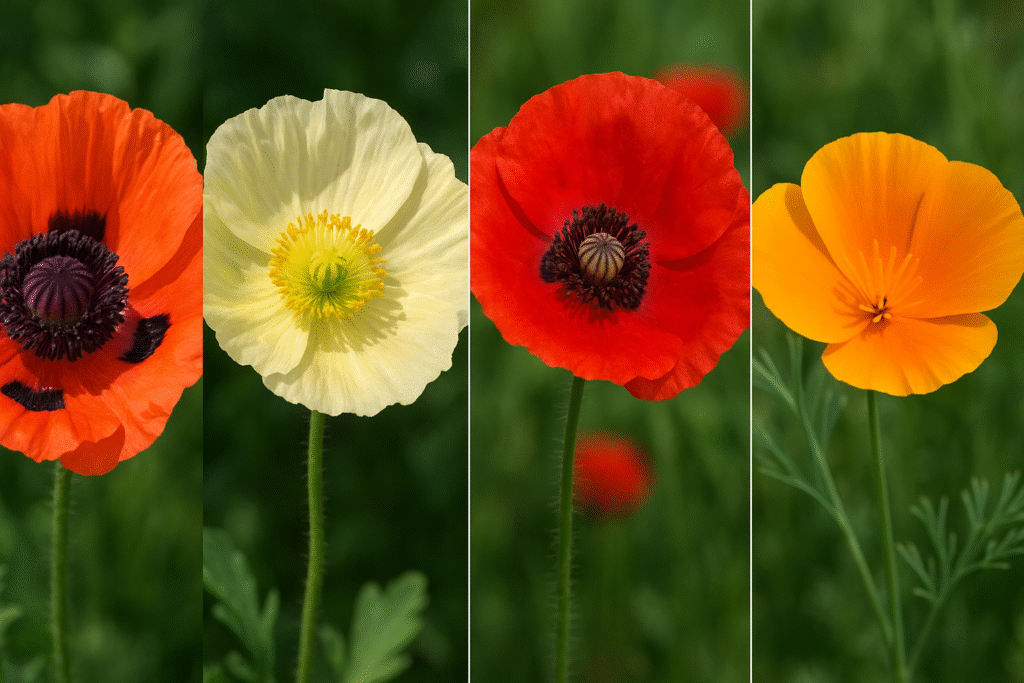
Not all poppies are created equal. Selecting the right type depends on your climate, garden size, and desired bloom period. Here are some of my favorites that I’ve personally grown:
| Poppy Type | Bloom Color | Bloom Time | Height | Special Notes |
|---|---|---|---|---|
| Oriental Poppy | Red, Orange, Pink, White | Late Spring to Early Summer | 24–36 in | Large, dramatic flowers; require well-drained soil |
| Iceland Poppy | White, Yellow, Pink, Orange | Late Spring to Early Summer | 12–18 in | Hardy in cooler climates; self-seeds easily |
| Shirley Poppy | White, Pink, Red | Summer | 12–18 in | Delicate petals; great for borders and containers |
| California Poppy | Orange, Yellow | Late Spring | 6–12 in | Drought-tolerant; ideal for wildflower gardens |
| Flanders Poppy | Red | Late Spring | 12–18 in | Classic remembrance poppy; easy to grow from seed |
When choosing a variety, think about your local climate. For instance, Iceland poppies thrive in northern U.S. gardens, while California poppies excel in drier, sunny areas. Mixing varieties can also extend your blooming season and create a garden that feels alive for months.
Choosing the Right Location and Soil
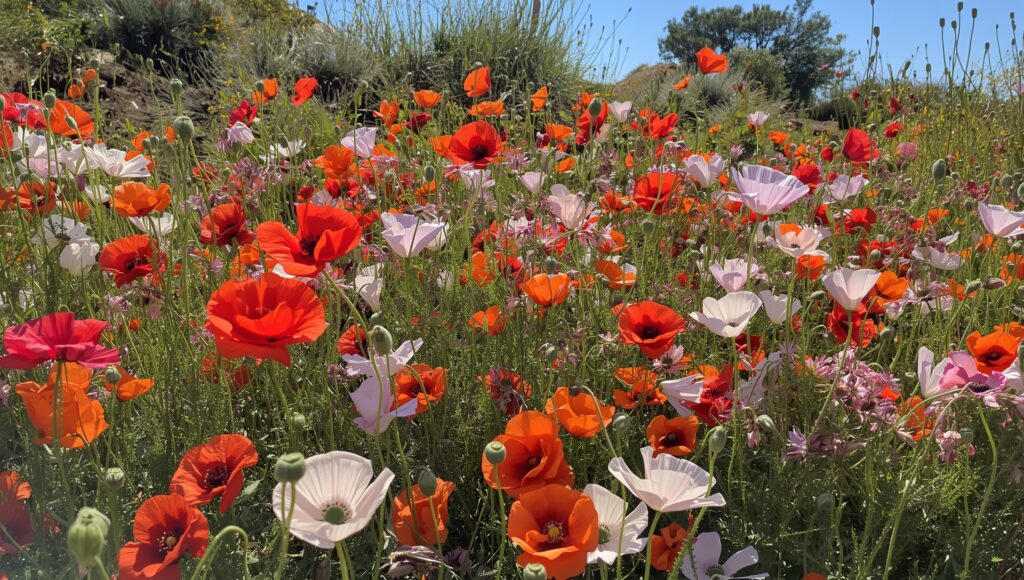
A successful poppy garden begins with selecting the right location and preparing the soil properly. I’ve learned over the years that even the healthiest seeds won’t flourish without good sunlight, correct soil pH, and proper drainage.
Ideal Sunlight & Temperature Conditions
Poppies adore the sun. Ideally, choose a spot with 6–8 hours of direct sunlight per day. Morning sun with afternoon shade can work for hotter regions, but insufficient sunlight often leads to fewer blooms. Most poppy varieties grow best in temperatures between 55°F and 70°F, though some, like Iceland poppies, tolerate cooler weather. For U.S. beginners, this means late spring is typically the best time to sow seeds in most zones.
Soil Requirements & pH Levels
Soil is crucial for healthy poppy growth. Over the years, I’ve noticed that flowers grown in light, well-draining soil thrive far better than those in heavy clay or waterlogged areas. Here are key points to consider:
- pH: Poppies prefer slightly acidic to neutral soil, ideally pH 6.0–7.0.
- Texture: Sandy loam works best; it ensures good drainage while retaining enough moisture.
- Amendments: Mix compost or well-rotted organic matter to enrich the soil without making it dense.
Remember, standing water is the enemy of poppies. Poor drainage can cause root rot and stunted growth, so elevating garden beds or adding sand to heavy soils makes a noticeable difference.
Preparing Your Garden Bed for Maximum Growth
Before planting, take the time to prep your bed:
- Clear weeds and debris to reduce competition.
- Loosen soil to a depth of 12 inches for healthy root development.
- Incorporate compost evenly across the bed to boost fertility.
- Check drainage by watering and ensuring no puddles remain.
By following these steps, your poppy seeds or transplants will have the perfect environment to establish strong roots and flourish.
Supporting Growth & Extending Bloom Season
Keeping poppies healthy throughout the season is all about consistent care and thoughtful strategies to extend their flowering. Over the years, I’ve discovered that small interventions—like removing spent blooms or pairing them with the right companion plants—make a huge difference in both plant health and visual impact.
Deadheading & Pruning for Longer Flowering
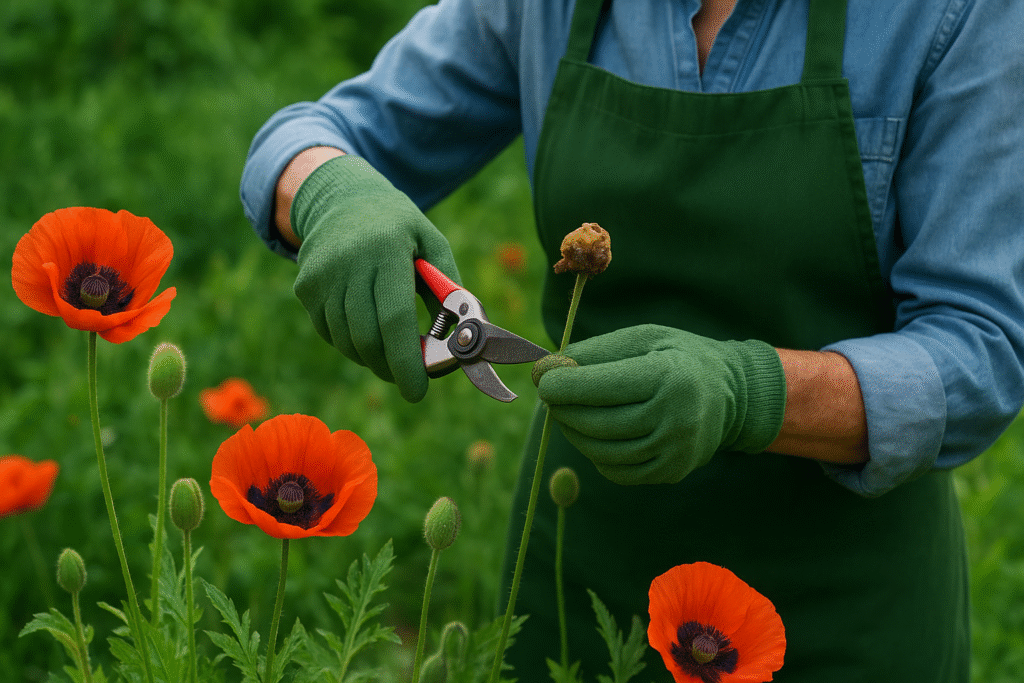
Deadheading, or removing faded flowers, is a simple yet powerful technique:
- Regularly pinch or cut off spent blooms just above the first set of leaves.
- This encourages the plant to focus energy on new flowers rather than seed production.
- Light pruning of leggy stems also improves airflow, reducing the risk of fungal diseases.
In my garden, a weekly deadheading routine has consistently extended poppy bloom periods by several weeks, giving me a longer season of vibrant color. By mastering these simple steps, you’ll see how easy it is to maintain a flourishing poppy patch.
Companion Planting to Boost Health & Aesthetics
Pairing poppies with other plants can enhance both growth and visual appeal:
- Lavender and Salvia: Their upright forms contrast beautifully with delicate poppy petals.
- Marigolds: Natural pest repellents that help protect poppies from aphids and caterpillars.
- Catmint or Alyssum: Groundcover plants that retain soil moisture and reduce weed competition.
Through careful companion planting, I’ve noticed fewer pests, healthier foliage, and a garden that looks more layered and alive. This approach is especially useful for beginners who want a low-maintenance yet eye-catching flower patch.
Seasonal Adjustments for Summer Heat & Frost
Poppies are hardy, but they do respond to environmental changes:
- Summer heat: Provide partial shade during the hottest part of the day, especially in southern U.S. climates. Mulching helps retain soil moisture.
- Frost: In early spring or late fall, protect tender young plants with row covers or light frost cloth.
- Wind protection: Taller varieties, like Oriental poppies, may need staking or a natural windbreak to prevent stem damage.
Adjusting care seasonally ensures your poppies remain robust, continue to bloom, and resist stress, no matter the weather.
Harvesting and Using Poppy Flowers
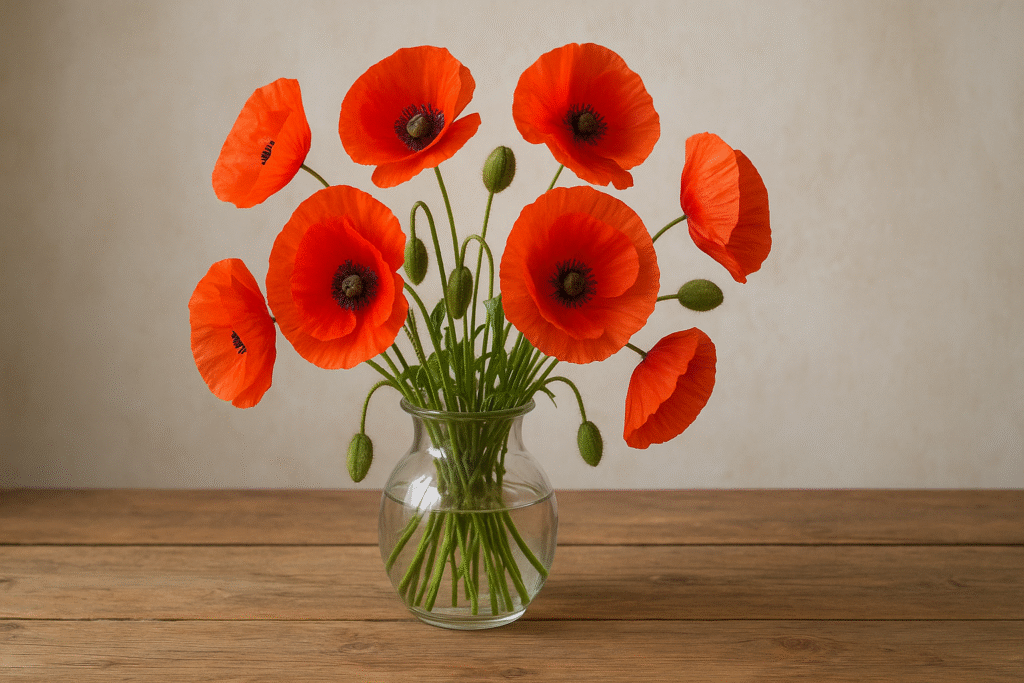
One of my favorite parts of growing poppies is cutting them for arrangements or preserving them for year-round enjoyment. Here’s how to make the most of your flowers.
When and How to Harvest Poppies for Bouquets
- Cut stems in the morning when blooms are fully open but before petals start to wilt.
- Use sharp, clean scissors to make a diagonal cut above a set of leaves.
- For long-lasting arrangements, place freshly cut poppies in cool water immediately.
Following this simple routine has allowed me to create bouquets that last a week or more while keeping the parent plants healthy and flowering.
Drying & Preserving Poppies
Drying poppies is a wonderful way to enjoy their beauty year-round:
- Hang stems upside down in a cool, dark, and dry area.
- Silica gel can also preserve color and shape more effectively for decorative crafts.
- Once dried, store in airtight containers or display in arrangements.
This method works beautifully for delicate Iceland or Shirley poppies, keeping their color vibrant and petals intact.
Creative Uses for Poppies in Your Garden or Home
Poppies aren’t just for flower beds—they can enhance your home and garden in many ways:
- Window boxes & containers: Perfect for small spaces or patios.
- Pressed flower art: Turn petals into bookmarks, cards, or framed decorations.
- Pollinator-friendly borders: Poppies naturally attract bees and butterflies, boosting your garden’s ecosystem.
By experimenting with different uses, I’ve found new ways to appreciate poppies beyond the garden bed, making them versatile and rewarding plants.
Conclusion
Growing poppies has been one of the most joyful experiences in my gardening journey. From selecting the right variety to watching those first delicate petals unfurl, each step is a lesson in patience, observation, and care. With the right sunlight, soil, and maintenance, your garden can flourish with vibrant poppies that attract pollinators, charm visitors, and brighten your home with cut arrangements. Remember, the key is consistent attention, thoughtful planting, and small tweaks that extend bloom season and plant health. By following these tips, you now know exactly how to grow poppies successfully, and I promise the rewards—both visually and emotionally—are worth every effort.
FAQs About Growing Poppies
How Long Does It Take for Poppies to Bloom?
Most poppies bloom 6–10 weeks after sowing, depending on the variety and climate. Oriental poppies may take longer, but Iceland and Shirley types usually flower within 2 months. Consistent watering and full sunlight accelerate growth.
Can Poppies Be Grown Indoors?
Yes, smaller varieties like Shirley or Iceland poppies can thrive indoors if provided bright, indirect sunlight and well-draining containers. Indoor-grown poppies may need supplemental light for optimal flowering, especially during shorter winter days.
How to Encourage More Blooms Per Plant
- Regular deadheading prevents seed formation and redirects energy to new flowers.
- Ensure 6–8 hours of sunlight daily and use a balanced fertilizer once or twice a season.
- Maintain good soil drainage to avoid root rot, which can reduce flowering.
Are Poppies Deer or Rabbit Resistant?
Generally, poppies are less appealing to deer and rabbits due to their slightly bitter foliage. However, local wildlife pressure varies—using protective netting or companion planting with pest-repellent plants can provide extra security.

